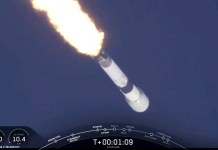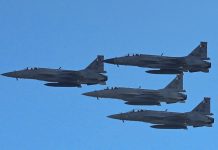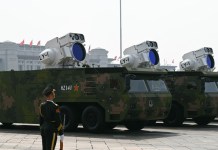In what could be termed as an effort to sustain its existing fleet, the Indian Air Force (IAF) has signed a deal with Hindustan Aeronautics Limited (HAL) to purchase two simulators for its nuclear-capable Jaguar aircraft.
China Responds To Taiwan’s F-16 Viper Deployment; Inducts ‘Most Advanced’ J-10 Fighters With Powerful BVR Missiles
This move spells a departure from its 2019 statement that said the Jaguar aircraft which has been in service for over four decades will be phased out starting 2023. Jaguar’s aging fleet and high cost of engines was the reason behind the decision at the time.
However, IAF is now procuring two Fixed-Base Full Mission Simulators (FBFMS) at a cost of Rs. 357 crores including a five-year comprehensive maintenance contract. The simulators will be stationed at the Jamnagar and Gorakhpur Air force stations and will provide advanced training to the fighter pilots.
With the help of these simulators, IAF will improve the quality of flight training by exposing pilots to diverse eventualities across the whole operating envelope, including simulation of sophisticated long-range weapons. The IAF had first vouched for the FBFMS for its Jaguar in 2014.
Since the maintenance contract with HAL has been signed for a duration of 5 years, the phasing out has apparently been put on hold. This move has come as a surprise because the inability of the government to procure heavy cost engines for the Jaguars and the reduced capacity of the aircraft to carry out operations was expected to see decommissioning of the Jaguar soon.
US Air Force’s 5K Pound ‘Bunker Buster’ Weapon Gets First Test; France Sells Its Own Heavy-Duty Armament To India
In what could be termed as a similar development earlier this year, the government had placed an order to purchase the phased out Mirage 2000 from France. Even then, many experts had expressed reservations about the decision of rehashing the same old fighter aircraft instead of buying new ones.
Jaguar Fighter Plane
Jaguar is a twin-engine, ground-attack aircraft that entered service in the IAF in 1979. The IAF currently has about 118 aircraft which were expected to be replaced by the Indian AMCA program. The French had retired its own fleet of Jaguars as early as 2005.

Due to an archaic engine that needs replacement owing to significant wear and tear, the aircraft keeps losing thrust with time and has reduced capacity by 15-20%. The aircraft is also ill-equipped to adequately perform its combat missions.
Jaguars fly at low altitudes at high speeds, delivering ordnance to ground targets in a single pass and then rushing back to base. Such trips necessitate increased engine power, which the plane has been losing for some years.
It could be speculated that instead of spending massive sums of money on engines for an aging aircraft, it decided to use that budget somewhere else.
“It seems that there is a massive cash crunch with the IAF. The budget outlay with the air force has anyway been low and has been reported in the past. They must have exhausted their budget with Rafale induction”, said Academic and Veteran Defense Journalist & Editor, Shashwat Gupta Ray in a previous interaction with EurAsian Times.
Looming Chinese Threat
With China making concerted efforts to up the ante at the disputed border, the need to maintain a fleet that is already short of its requisite strength could be seen as a reason for India refurbishing its aging fighters.
Apart from Jaguar, the Mirage and Mig-29s are also being upgraded. To enable them to operate as four-plus generation aircraft, these planes are undergoing new armaments and avionics upgrades. This renovation should be finished by the end of the year.
The statement regarding the contract mentions “training the pilots for various contingencies in the entire operating envelope.” This could be an indirect reference to the two adversaries at its borders, including the one that has been actively using its aircraft to intimidate the Indian troops.
The LCA MK1, MK1A, and MK2 along with the Advanced Medium Combat Aircraft (AMCA), an upcoming indigenous twin-engine, all-weather multi-role 5th generation fighter will take time to be fully inducted as envisioned.
Efforts are being made to enhance the capability of India’s indigenous aircraft, like integrating HAMMER missiles on LCA Tejas. With the Chinese threat refusing to die down, the Indian Air Force could be focusing on its operational preparedness with every aircraft in its inventory. At the moment, it remains 10 short of the required squadrons in the face of a two-front war.
Earlier this year, the Indian Air Force Chief had told the media that even though efforts are being made to induct new fighters in the IAF, it still won’t be able to achieve the sanctioned strength of 42.
“Though there are plans to induct new fighters to replace the fighters which are being phased over the next 3-4 years. However, over the next 10-15 years, IAF will not be able to have the mandated 42 squadrons, said VR Chaudhari, the Air Chief Marshal of the IAF. This could be understood as a pragmatic rationale behind the upgrade of older jets and a delay in their decommissioning. The IAF could be buying time and rationing its fleet as the Chinese threat becomes more amplified.
- Contact the author at sakshi.tiwari9555@gmail.com
- Follow EurAsian Times on Google News




